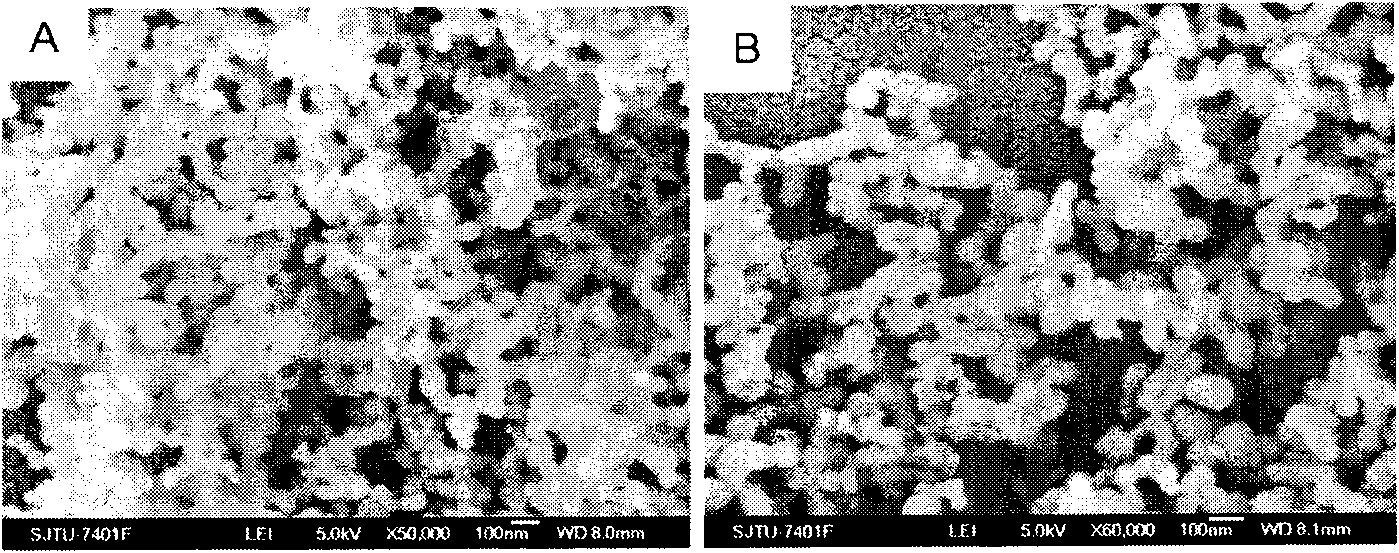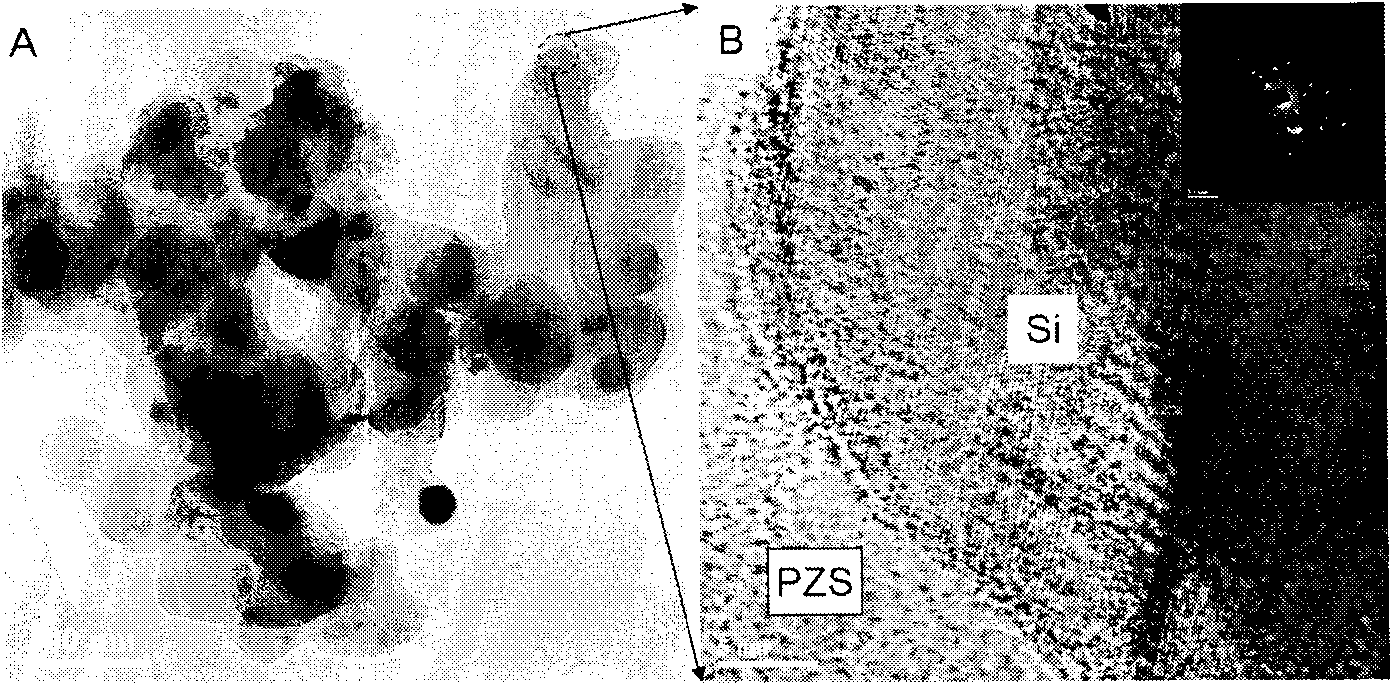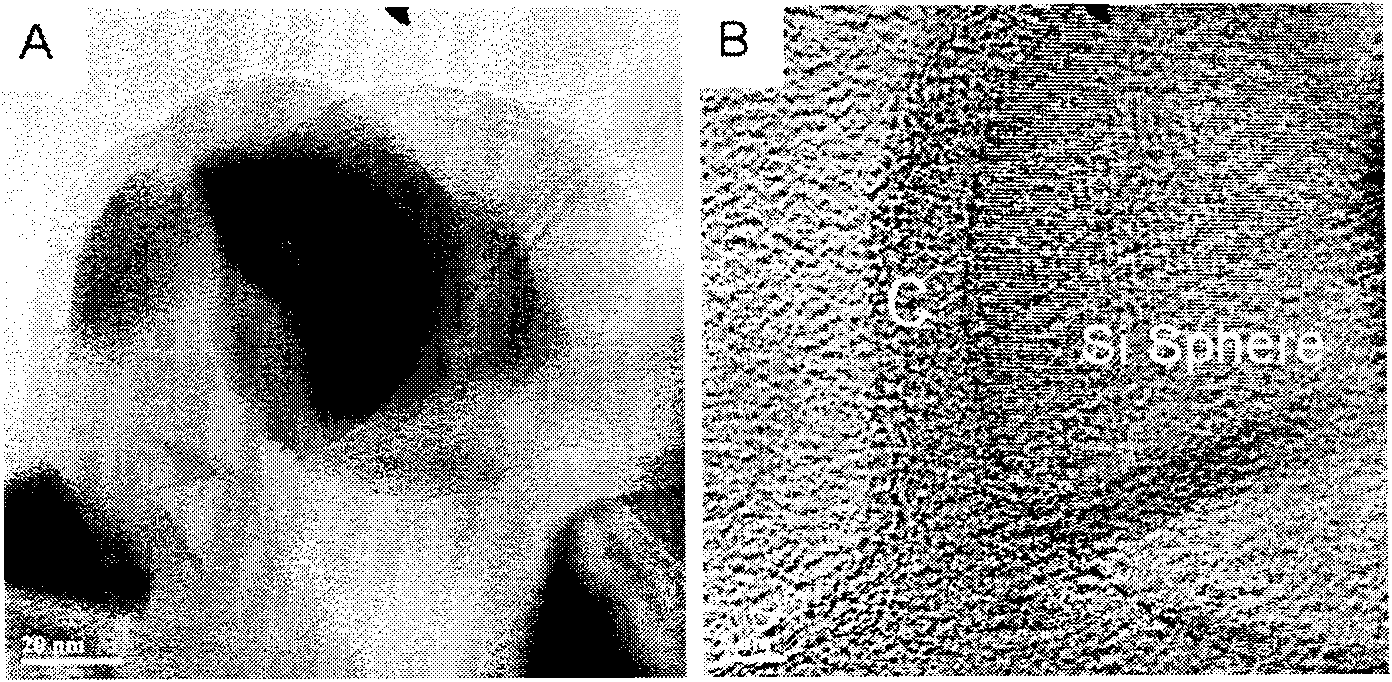Preparation method of silicon/porous carbon nano-composite particle
A nano-composite, porous carbon technology, applied in the preparation of microspheres, microcapsule preparations, etc., can solve the problems of low lithium storage capacity of silicon-carbon composite materials, the cycle stability needs to be improved, and the cycle stability is not good enough, so as to achieve a good cycle Effects of stability, tight binding, and high specific capacity
- Summary
- Abstract
- Description
- Claims
- Application Information
AI Technical Summary
Problems solved by technology
Method used
Image
Examples
Embodiment 1
[0020] In a 100 ml flask, disperse 0.04 g of silicon spheres into 60 ml of tetrahydrofuran and ethanol mixed solvent, wherein the volume ratio of tetrahydrofuran to ethanol is 1:1, then add 0.04 g of hexachlorocyclotriphosphazene, 0.087 g of 4,4 '-Dihydroxydiphenyl sulfone and 0.5 mg of acid-binding agent triethylamine; ultrasonically react for 6-10 hours at 20-40°C, wherein the ultrasonic power is 100 watts, and the ultrasonic frequency is 40 kHz; Separate, wash with tetrahydrofuran, wash with deionized water, and dry in vacuum for 20 to 24 hours to obtain silicon / polyphosphazene nanocomposite microspheres with a core-shell structure; move the obtained silicon / polyphosphazene nanocomposite microspheres into In the quartz tube carbonization device, under the protection of high-purity nitrogen, the temperature was raised at a heating rate of 5°C / min, kept at 600°C for 2 hours, and then continued to rise to the predetermined temperature of the sample at a rate of 5°C / min at 900°C...
Embodiment 2
[0027] In a 100 ml flask, disperse 0.04 g of silicon spheres into 60 ml of tetrahydrofuran and ethanol mixed solvent, wherein the volume ratio of tetrahydrofuran to ethanol is 1:1, then add 0.04 g of hexachlorocyclotriphosphazene, 0.087 g of 4,4 '-Dihydroxydiphenyl sulfone and 0.5 mg of acid-binding agent triethylamine; ultrasonically react for 6-10 hours at 20-40°C, wherein the ultrasonic power is 100 watts, and the ultrasonic frequency is 40 kHz; Separate, wash with tetrahydrofuran, wash with deionized water, and dry in vacuum for 20 to 24 hours to obtain silicon / polyphosphazene nanocomposite microspheres with a core-shell structure; move the obtained silicon / polyphosphazene nanocomposite microspheres into In the quartz tube carbonization device, under the protection of high-purity nitrogen, the temperature was raised at a heating rate of 5°C / min, kept at 600°C for 2 hours, and then continued at a heating rate of 5°C / min to the predetermined sample temperature of 1000°C, and ...
Embodiment 3
[0029] In a 100 ml flask, disperse 0.04 g of silicon spheres into 60 ml of tetrahydrofuran and ethanol mixed solvent, wherein the volume ratio of tetrahydrofuran to ethanol is 1:1, then add 0.04 g of hexachlorocyclotriphosphazene, 0.087 g of 4,4 '-Dihydroxydiphenyl sulfone and 0.5 mg of acid-binding agent triethylamine; ultrasonically react for 6-10 hours at 20-40°C, wherein the ultrasonic power is 100 watts, and the ultrasonic frequency is 40 kHz; Separate, wash with tetrahydrofuran, wash with deionized water, and dry in vacuum for 20 to 24 hours to obtain silicon / polyphosphazene nanocomposite microspheres with a core-shell structure; move the obtained silicon / polyphosphazene nanocomposite microspheres into In the quartz tube carbonization device, under the protection of high-purity nitrogen, the temperature was raised at a heating rate of 5°C / min, kept at 600°C for 2 hours, and then continued to rise to the predetermined temperature of the sample at a rate of 5°C / min at 700°C...
PUM
| Property | Measurement | Unit |
|---|---|---|
| Diameter | aaaaa | aaaaa |
| Thickness | aaaaa | aaaaa |
Abstract
Description
Claims
Application Information
 Login to View More
Login to View More - R&D
- Intellectual Property
- Life Sciences
- Materials
- Tech Scout
- Unparalleled Data Quality
- Higher Quality Content
- 60% Fewer Hallucinations
Browse by: Latest US Patents, China's latest patents, Technical Efficacy Thesaurus, Application Domain, Technology Topic, Popular Technical Reports.
© 2025 PatSnap. All rights reserved.Legal|Privacy policy|Modern Slavery Act Transparency Statement|Sitemap|About US| Contact US: help@patsnap.com



